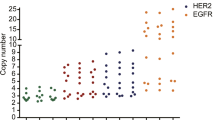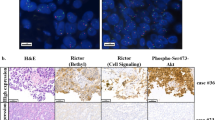Abstract
Background
Angiogenesis plays a pivotal role in neoplastic growth and metastasis formation. Vascular endothelial growth factor A (VEGFA) is a major player in physiological and tumour-induced angiogenesis and numerous human tumours have been show to overexpress VEGFA. Moreover increased VEGFA gene expression has been found frequently to correlate with tumour progression, recurrences and survival. Interestingly, several studies have demonstrated that gene amplification may result in protein overexpression and that amplification of the therapeutics’ target gene can serve as an excellent predictive marker (i.e. HER2 and trastuzumab). However the impact of VEGFA gene amplification has been only recently assessed for some cancer types such as osteosarcoma, colorectal, breast and liver cancer.
Aims
This study aimed to assess VEGFA gene amplification status using fluorescent in situ hybridization (FISH) in a large cohort of different tumour entities. Thus, we investigated the incidence of VEGFA amplification using a multi-tumour tissue microarray (TMA) containing 2,837 evaluable specimens from 80 different tumour entities and 31 normal tissue types. Moreover, we validated FISH analysis as reference method to evaluate VEGFA gene status by comparing it to comparative genomic hybridization (CGH).
Results
We observed that VEGFA locus amplification and/or polysomy represented a small but regularly detected population in several tumour entities while was not present in normal tissues. VEGFA gene alterations were predominantly observed in hepatocarcinomas, adenocarcinomas of the pancreas and intestine, large cell carcinoma of the lung and in endometrium serous carcinoma. Furthermore our data demonstrated that VEGFA detection by FISH provided highly comparable results to those generated by CGH.
Conclusion
Albeit with low percentage, VEGFA amplification is commonly observed across several tumour entities. Furthermore, our results demonstrated that FISH test could be used as a reliable diagnostic tool to evaluate VEGFA gene status in human specimens.
Access this article
We’re sorry, something doesn't seem to be working properly.
Please try refreshing the page. If that doesn't work, please contact support so we can address the problem.



Similar content being viewed by others
References
Ellis LM, Hicklin DJ (2008) VEGF-targeted therapy: mechanisms of anti-tumour activity. Nat Rev Cancer 8:579–591
Eppenberger U, Kueng W, Schlaeppi JM, Roesel JL, Benz C, Mueller H et al (1998) Markers of tumor angiogenesis and proteolysis independently define high- and low-risk subsets of node-negative breast cancer patients. JCO 16:3129–3136
Hubbard J, Grothey A (2010) Antiangiogenesis agents in colorectal cancer. Curr Opin Oncol 22:374–380
Fan F, Samuel S, Gaur P, Lu J, Dallas NA, Xia L et al (2011) Chronic exposure of colorectal cancer cells to bevacizumab promotes compensatory pathways that mediate tumour cell migration. Br J Cancer 104:1270–1277
Bergers G, Benjamin LE (2003) Tumorigenesis and the angiogenic switch. Nat Rev Cancer 3:401–410
Vlajnic T, Andreozzi MC, Schneider S, Tornillo L, Karamitopoulou E, Lugli A et al (2011) VEGFA gene locus (6p12) amplification identifies a small but highly aggressive subgroup of colorectal cancer [corrected] patients. Mod Pathol 24:1404–1412
Schneider BP, Gray RJ, Radovich M, Shen F, Vance G, Li L et al (2013) Prognostic and predictive value of tumor vascular endothelial growth factor gene amplification in metastatic breast cancer treated with paclitaxel with and without bevacizumab; results from ECOG 2100 trial. Clin Cancer Res 19:1281–1289
Baumhoer D, Tornillo L, Stadlmann S, Roncalli M, Diamantis EK, Terracciano LM (2008) Glypican 3 expression in human nonneoplastic, preneoplastic, and neoplastic tissues: a tissue microarray analysis of 4,387 tissue samples. Am J Clin Pathol 129:899–906
Heaphy CM, Subhawong AP, Hong SM, Goggins MG, Montgomery EA, Gabrielson E et al (2011) Prevalence of the alternative lengthening of telomeres telomere maintenance mechanism in human cancer subtypes. Am J Pathol 179:1608–1615
Sauter G, Moch H, Carroll P, Kerschmann R, Mihatsch MJ, Waldman FM (1995) Chromosome-9 loss detected by fluorescence in situ hybridization in bladder cancer. IJC 64:99–103
Wolff AC, Hammond M, Schwartz JN et al (2007) American society of clinical oncology/college of american pathologists guideline recommendations for human epidermal growth factor receptor 2 testing in breast cancer. JCO 25:118–145
Salido M, Tusquets I, Corominas JM, Suarez M, Espinet B, Corzo C et al (2005) Polysomy of chromosome 17 in breast cancer tumors showing an overexpression of ERBB2: a study of 175 cases using fluorescence in situ hybridization and immunohistochemistry. BCR 7:R267–R273
Torrisi R, Rotmensz N, Bagnardi V, Viale G, Curto BD, Dell’orto P et al (2007) HER2 status in early breast cancer: relevance of cell staining patterns, gene amplification and polysomy 17. Eur J Cancer 43:2339–2344
Tapia C, Savic S, Wagner U, Schonegg R, Novotny H, Grilli B et al (2007) HER2 gene status in primary breast cancers and matched distant metastases. BCR 9:R31
Ma Y, Lespagnard L, Durbecq V, Paesmans M, Desmedt C, Gomez-Galdon M et al (2005) Polysomy 17 in HER-2/neu status elaboration in breast cancer: effect on daily practice. Clin Cancer Res 11:4393–4399
Team RC (2012) A language and environment for statistical computing. R Foundation for Statistical Computing, Vienna, Austria ISBN 3-900051-07-0, URL http://cran.case.edu/web/packages/dplR/vignettes/timeseries-dplR.pdf
Gentleman RC, Carey VJ, Bates DM, Bolstad B, Dettling M, Dudoit S et al (2004) Bioconductor: open software development for computational biology and bioinformatics. Genome Biol 5:R80
Mike L, Smith JCM, Steven McKinney, Thomas Hardcastle and Natalie P (2009) Thorne snapCGH: Segmentation, normalisation and processing of aCGH data. R package version 1280
Olshen AB, Venkatraman ES, Lucito R, Wigler M (2004) Circular binary segmentation for the analysis of array-based DNA copy number data. Biostatistics 5:557–572
Olshen. VESaA. DNAcopy: DNA copy number data analysis. R package version 1320
Santos GC, Zielenska M, Prasad M, Squire JA (2007) Chromosome 6p amplification and cancer progression. J Clin Pathol 60:1–7
Chiang DY, Villanueva A, Hoshida Y, Peix J, Newell P, Minguez B et al (2008) Focal gains of VEGFA and molecular classification of hepatocellular carcinoma. Cancer Res 68:6779–6788
Weir BA, Woo MS, Getz G, Perner S, Ding L, Beroukhim R et al (2007) Characterizing the cancer genome in lung adenocarcinoma. Nature 450:893–898
Knuutila S, Bjorkqvist AM, Autio K, Tarkkanen M, Wolf M, Monni O et al (1998) DNA copy number amplifications in human neoplasms: review of comparative genomic hybridization studies. Am J Pathol 152:1107–1123
Yoon HH, Shi Q, Sukov WR, Lewis MA, Sattler CA, Wiktor AE et al (2012) Adverse prognostic impact of intratumor heterogeneous HER2 gene amplification in patients with esophageal adenocarcinoma. JCO 30:3932–3938
Tse CH, Hwang HC, Goldstein LC, Kandalaft PL, Wiley JC, Kussick SJ et al (2011) Determining true HER2 gene status in breast cancers with polysomy by using alternative chromosome 17 reference genes: implications for anti-HER2 targeted therapy. JCO 29:4168–4174
Ley TJ et al (2013) Genomic and epigenomic landscapes of adult de novo acute myeloid leukemia. N Engl J Med 368:2059–2074
Barretina J, Taylor BS, Banerji S, Ramos AH, Lagos-Quintana M, Decarolis PL et al (2010) Subtype-specific genomic alterations define new targets for soft-tissue sarcoma therapy. Nat Genet 42:715–721
Nagano A, Ohno T, Shimizu K, Hara A, Yamamoto T, Kawai G et al (2010) EWS/Fli-1 chimeric fusion gene upregulates vascular endothelial growth factor-A. IJC 126:2790–2798
Kreuter M, Paulussen M, Boeckeler J, Gerss J, Buerger H, Liebscher C et al (2006) Clinical significance of Vascular Endothelial Growth Factor-A expression in Ewing’s sarcoma. Eur J Cancer 42:1904–1911
Yang J, Yang D, Sun Y, Sun B, Wang G, Trent JC et al (2011) Genetic amplification of the vascular endothelial growth factor (VEGF) pathway genes, including VEGFA, in human osteosarcoma. Cancer 117:4925–4938
Goel S, Duda DG, Xu L, Munn LL, Boucher Y, Fukumura D et al (2011) Normalization of the vasculature for treatment of cancer and other diseases. Physiol Rev 91:1071–1121
Acknowledgments
This work was supported by the Swiss National Foundation (Grant NMS1651). We would like to acknowledge Prof. Heiner Fiebig and Dr. Fred (Oncotest GmbH) for providing slides of their multi-tumour TMAs. We thank S. Schneider at the Institute of Pathology in Basel for her excellent technical support.
Conflict of interest
M.A., L.Q., J.G., C.R., S.E.C., L.T. and L.M.T. declare no competing financial interests. V.V. is employed by Oncotest GmbH.
Author information
Authors and Affiliations
Corresponding author
Electronic supplementary material
Below is the link to the electronic supplementary material.
10456_2013_9396_MOESM1_ESM.tif
Supplementary Table 1. Rates of VEGFA gene locus amplification in the analysed tumour types as evaluated using FISH, extended version (TIFF 1924 kb)
10456_2013_9396_MOESM2_ESM.tif
Supplementary Table 2. Rates of VEGFA gene locus amplification using the alternative cut off criterion in selected tumour types as evaluated using FISH (TIFF 1068 kb)
10456_2013_9396_MOESM3_ESM.tif
Supplementary Table 3. Rates of VEGFA gene locus amplification using the alternative cut off criterion in the analysed tumour types as evaluated using FISH, extended version (TIFF 4245 kb)
10456_2013_9396_MOESM4_ESM.tif
Supplementary Table 4. Rates of VEGFA gene locus amplification in human analysed tumour xenografts as evaluated by FISH, extended version (TIFF 1744 kb)
10456_2013_9396_MOESM5_ESM.tif
Supplementary Table 5. Rates of VEGFA gene locus amplification in human selected tumour xenografts using the alternative cut off criterion as evaluated by FISH (TIFF 692 kb)
10456_2013_9396_MOESM6_ESM.tif
Supplementary Table 6. Rates of VEGFA gene locus amplification in human tumour xenografts using the alternative cut off criterion as evaluated by FISH (TIFF 885 kb)
Rights and permissions
About this article
Cite this article
Andreozzi, M., Quagliata, L., Gsponer, J.R. et al. VEGFA gene locus analysis across 80 human tumour types reveals gene amplification in several neoplastic entities. Angiogenesis 17, 519–527 (2014). https://doi.org/10.1007/s10456-013-9396-z
Received:
Accepted:
Published:
Issue Date:
DOI: https://doi.org/10.1007/s10456-013-9396-z




